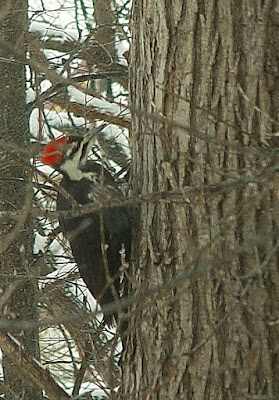We heard the shrill whinnying calls of the male Pileated Woodpecker
Dryocopus pileatus as he made his way through the woods, then came to the suet block for breakfast. He thrust his strong beak into the food, scattering some crumbs to the ground and gulping a few pieces into his gullet. Once he had a mouthful, he went to a nearby tree where he used the rough bark to hold the suet as he consumed it. His tongue has a spear-like tip bearing backward-facing barbs that allow him to lick food items from between the folds of tree bark. Pileated Woodpeckers' favorite food is carpenter ants; also other ants, wood boring beetle larvae, termites, flies, caterpillars, cockroaches, grasshoppers, wild fruits and nuts.
Woodpeckers have zygodactyl feet (two toes facing forward, one facing back) and allows these birds to easily climb and grasp bark, tree branches and other structures.





























